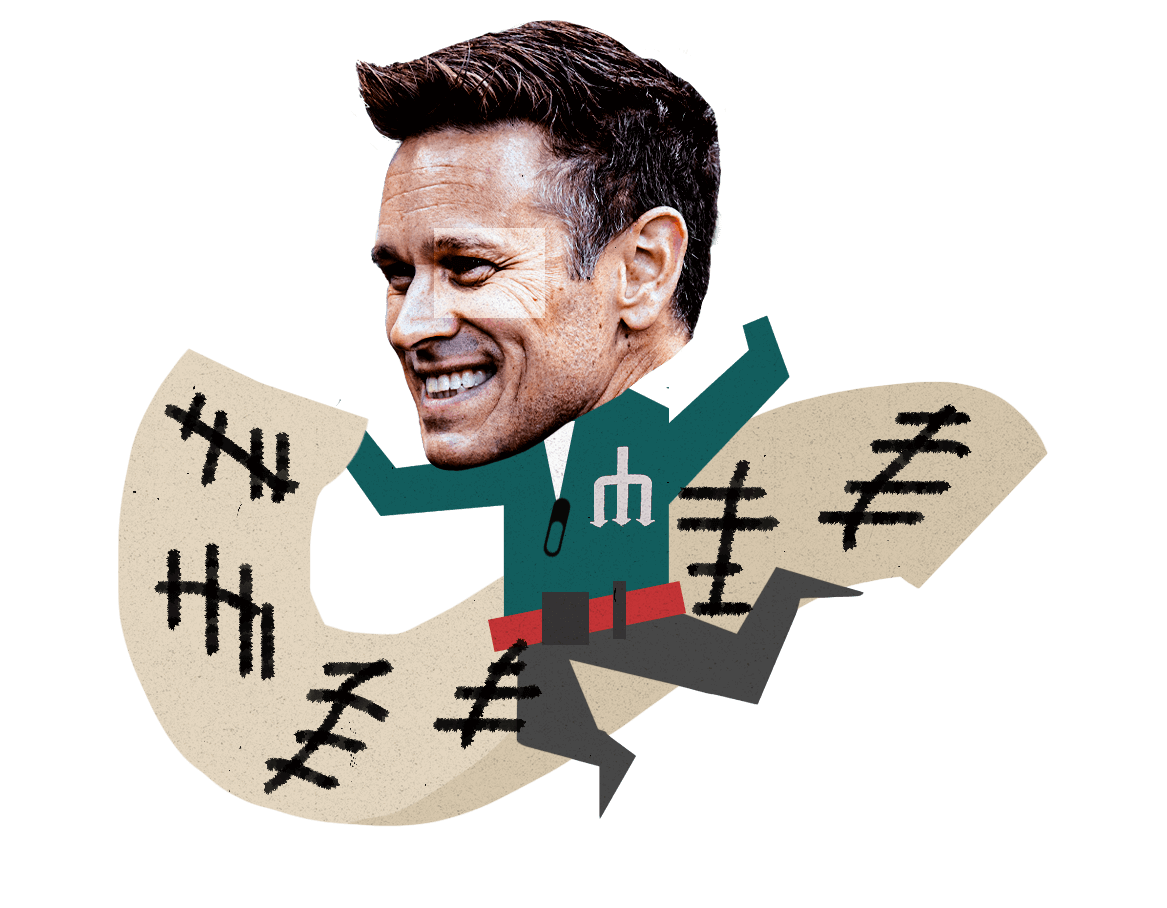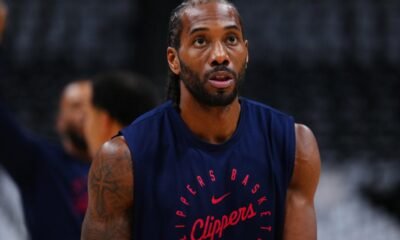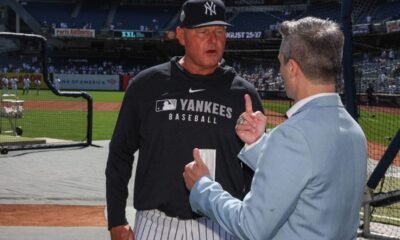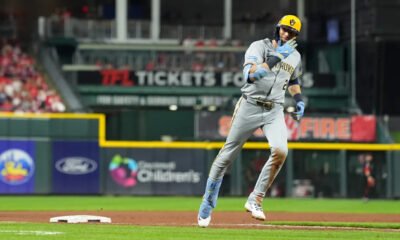The Athletic has live coverage of the 2025 MLB trade deadline.
This is the first of a three-part series examining how the personalities of MLB executives impact baseball’s trade deadline. Part two is coming Tuesday.
The display screen on Jerry Dipoto’s iPhone can elicit in him despair or delight. It just depends on who is calling.
“Sometimes, the phone is going to ring and the first thing you think is, ‘Oh, god,’” Dipoto said. “You know that the likelihood of getting a deal done isn’t very high.”
Dipoto, the Seattle Mariners’ president of baseball operations, does not feel that way when he receives a call from A.J. Preller, his counterpart with the San Diego Padres. The two clubs share a spring training complex. Their two chief baseball executives share a propensity for action.
“We know each other’s players inside and out,” Dipoto said. “I’d be lying to you if I didn’t say that both A.J. and I love to deal. It’s intriguing to get on the phone and see what’s possible.”
At this time of year, as the trade deadline approaches, executives must figure out which players on rival clubs are available and how to acquire them. To do so, the execs must understand how their contemporaries see the world and operate within it. The personalities of Major League Baseball executives form the game’s hidden undercurrent.
There are hunters who identify their targets and make clear their demands. There are fishermen who cast lines far and wide across the sport. There are volume shooters who believe completing a trade is more valuable than maximizing the return in every transaction. There is the skull-crushing ennui of dealing with the Colorado Rockies and the exquisite torture of trying to finalize a transaction with the Cleveland Guardians.
There are executives, like Milwaukee Brewers general manager Matt Arnold, who sketch elaborate, three-team deals. Others avoid gambits like that. “I’m not smart enough to do it,” Arizona Diamondbacks general manager Mike Hazen said. “Honestly. I mean, that’s the honest answer. Do you want me to lie to you?”
Some, like Tampa Bay Rays president of baseball operations Erik Neander, prefer texting. Cashman can pepper his messages with GIFs. Others, like Anthopoulos and Preller, like to kibitz on the phone. In order to do the job, several executives explained, you need to know how to connect with your counterparts. “You talk to everybody a little bit differently, based on past history and what you think may resonate with them,” Preller said.
To be a successful executive requires an understanding of your peers. To understand these interpersonal dynamics as the deadline approaches, The Athletic canvassed more than two dozen executives about how relationships can facilitate transactions. Some requested anonymity in order to speak freely about their competitors. The conversations provided a partial taxonomy of the decision-making executives about to embark on deadline dealing.
In other words, when the phone rings, do you want to pick up?
The Hunters
A few days after the final out of the 2022 World Series, as baseball executives gathered in Las Vegas for the GM Meetings, Alex Anthopoulos approached Kansas City Royals executive J.J. Picollo. The two men had crossed paths for years in scouting circles, but were not particularly close. Anthopoulos intended to trade pitcher Jake Odorizzi and wondered if Kansas City wanted him. Picollo had just taken over the Royals’ baseball operations department after spending his career in player development, and was still learning the transactional rhythms.
“I went upstairs and said, ‘Guys, do we have interest in Odorizzi?’” Picollo said. “We were kicking it around, kicking it around. The next day (Anthopoulos) traded him. OK. I learned something. If he calls, it’s going to happen.”
As an assistant general manager with the Toronto Blue Jays, Anthopoulos often grew frustrated at hours wasted in offseason meetings. The executives would speculate about trade targets. “And I would think to myself: Do we even know if that player is available?” he said. Or the group would canvass the lobby for information. “It never made sense to me,” Anthopoulos said. “Why aren’t we just asking directly? Let’s get an answer.”
So Anthopoulos makes calls. And makes calls. And makes calls.
When he became a chief executive, first with Toronto in 2009 and later in Atlanta in 2017, Anthopoulos established himself as one of the sport’s foremost hunters. Anthopoulos chuckled as he recalled the mantra of former Braves president John Schuerholz: “N.D.A.: no d—ing around.” He noted how former Chicago Cubs general manager Jim Hendry told him, “I’m so candid and transparent that the other side doesn’t believe me.”

Anthopoulos takes a similar tack. He considers it a courtesy to his rivals. “I’m so conscious of not wasting the other side’s time,” Anthopoulos said. “Because when you’re saying, ‘I’m interested in so-and-so. Can you give me a price?’ you’re creating a lot of work for that team. They’re going through your system. They’re meeting, they’re talking to people. It’s disrespectful, to me, if you’re not real.”
His peers described themselves as appreciative of his frankness and entertained by his vigor. He thinks fast and speaks faster. “He can rifle through 30 names before you get to the point where you take your first breath,” Dipoto said. One executive, who insisted he harbored great affection for Anthopoulos, suggested he avoids him near the deadline because “I can’t get him off the damn phone.”
“Alex can be very transparent,” New York Mets president of baseball operations David Stearns said. “He’s also very smart. And isn’t going to give up information he doesn’t think he needs to give up to get a deal done.”
Dave Dombrowski, the Philadelphia Phillies’ president of baseball operations, uses a similar approach, if less frenetic energy. He became a general manager for the first time in 1988, with the Montreal Expos. On Sunday, he turned 69. When a new chief baseball officer gets promoted, Dombrowski likes to reach out with congratulations. He intends to establish a baseline for future business.
“I think the most important thing is you’re always staying in contact with everybody as much as you can,” Dombrowski said. “You have a pulse for what everybody is trying to do.”
That foregrounding allows Dombrowski to pounce during the summer. In an era where executives fret over losing prospects for short-term rentals, Dombrowski often makes offers that stand out. “Because the industry has gotten so obsessed with future value, if you focus on present value you can win a lot of deals,” one executive said. “And he always focuses on present value.”
Brian Cashman, now in his 27th season as New York Yankees general manager, does not operate with the same disregard for perceived risk. But like Dombrowski, rival executives said, Cashman starts discussions with clarity.
“He has a really clear sense of what he will or won’t do,” Guardians president of baseball operations Chris Antonetti said. “And he’ll tell you that.” Added Minnesota Twins president of baseball operations Derek Falvey, “Cash is usually pretty direct and pretty straightforward about where he wants to go. With other teams, you know there’s probably a lot longer feeling-out process.”
Cashman framed his style as a matter of humility.
“I’m not the smartest person in the room,” Cashman said. “So there’s no manipulation, there’s no sleight of hand. I cut to the chase. I don’t play games. I don’t have time.”
During a conversation this spring, Anthopoulos sounded amused when told about how his other executives perceive him. He takes pride in his approach, but understands it can be imperfect.
“Being decisive can help if you’re competing with someone who is being indecisive,” Anthopoulos said. “But that doesn’t stop you from making a bad trade.”
The Fisherman and the Juggler
A rival executive conjured a metaphor for A.J. Preller that was fitting for an executive who often wears bucket hats and basketball shorts.
“I picture him in a boat in the middle of a lake, with 1,000 lines in the water,” the executive said.
A different executive crafted a similar image for Andrew Friedman — a juggler tasked with keeping all his options viable. The two illustrations are fitting for a pair of executives who operate in different ways but end up in similar positions. “Andrew works his network,” one executive said. “He’s really f—ing good. And he knows what’s going on out there. And A.J. does, too — on a different network.”
The Padres hired Preller in the summer of 2014. Two months later, Friedman arrived in Los Angeles. The teams executed a significant swap that winter, with catcher Yasmani Grandal joining the Dodgers in exchange for outfielder Matt Kemp. Since then, the two executives are far more often in competition. On the field, the Dodgers and Padres have established the sport’s most bitter rivalry. Off the field, the front offices compete for the same players, from Mookie Betts to Juan Soto to Roki Sasaki.
The conflict can confound other teams. A common complaint from third parties at the deadline is that they are unsure if the Dodgers are actually interested in a player or just trying to inflate the price for the Padres — or vice versa. Clubs do not doubt Preller’s sincerity, but worry about other options he is pursuing. “You can think you’re going to do a deal with A.J.,” one executive said. “But just beware that he’s having 900 calls a day, and he’s going to do the one deal that is best for him. And it is very easy to get left out in the cold.”
Preller, 48, started as a scout. He prides himself on still scouring the backfields and visiting high school fields. He tries to puzzle out how different players appeal to different clubs. “The better clubs, they understand what these teams are trying to do,” Preller said. “I think having a feel for that is huge. And having a feel for value, like a realistic view of how the other teams are valuing their players.”
Friedman, 48, began his career in finance. No executive, his peers say, better understands the movements of markets. His former lieutenants in Tampa Bay now run front offices across the sport. His executive tree rivals that of Sean McVay and Kyle Shanahan in the NFL. But Friedman also maintains dialogue with other clubs, storing information and planting seeds.
“Making trades is really difficult,” Friedman said. “And the better you can understand the other team’s objectives, what they’re trying to accomplish, it at least makes it easier.”
Before last season, the Dodgers had spent years trying to pry utilityman Tommy Edman from the St. Louis Cardinals. In the winter after 2023, Chicago White Sox general manager Chris Getz recalled, the two teams discussed three-team concepts that could bring Edman to Los Angeles. Several months later, in the midst of a historically bad team’s fire sale, the White Sox served as the middleman in a trade that sent Edman and White Sox reliever Michael Kopech to the Dodgers. “What Andrew is really f—ing good at is he doesn’t leave any stone unturned,” one executive said.
Edman and Kopech solidified a Dodgers roster that defeated the Padres in the National League Division Series en route to a championship. The outcome only crystallized the challenge facing Preller. He viewed his mandate from then-owner Peter Seidler as conquering the Dodgers and capturing the first World Series in San Diego history. Seidler, who died in November 2023, authorized unprecedented spending in free agency. Preller pursued seismic upgrades through trades, from former American League Cy Young Award winner Blake Snell to flame-throwing closer Josh Hader to, of course, Soto.
To do so, Preller has demonstrated a willingness to skim the cream from his farm system. In the summer of 2022, Preller built a colossal package to acquire Soto, including three players who have become All Stars: shortstop CJ Abrams, pitcher MacKenzie Gore and outfielder James Wood. Preller has insisted he harbors no regrets about the deal, even after payroll constraints forced him to trade Soto away heading into 2024.
Preller remained undaunted last summer. He shipped out two first-round picks from 2022 (pitcher Dylan Lesko, as part of a deal for Rays reliever Jason Adam; and pitcher Robby Snelling, as part of a deal for Miami Marlins reliever Tanner Scott) and the team’s first-rounder from 2023 (outfielder Dillon Head, in a package for Marlins infielder Luis Arraez). “A.J.,” one rival executive chuckled, “ain’t scared.”
The haul was not enough to take down the Dodgers. But Preller will keep trying. And he does not intend to alter his strategy. “He’s told me this before over the years: ‘We’re willing to do something stupid — not crazy,’” Dipoto said.
“We’re going to trade good players to get players,” Preller said. “We’re willing to make moves.”
A successful fisherman needs enticing bait.
The Grind Machine
As last Christmas drew near, Mike Hazen found himself in an unfamiliar position. He was about to complete a trade with the Guardians. Hazen cut his teeth in Cleveland’s front office two decades ago. He considers the team’s chief executives, Chris Antonetti and general manager Mike Chernoff, “some of my best friends in the world.” That doesn’t make negotiating with his pals any easier.
“In fact, Chernoff and I were joking about, ‘Are we actually going to get a trade done?’” Hazen said. Then Chernoff mentioned other teams were showing interest. “And I was like, ‘Here we go again.’”
Eventually the two clubs finalized a deal. Arizona received first baseman Josh Naylor in return for pitcher Slade Cecconi. But it is never easy with Cleveland, rival executives say. The team keeps it vague early in discussions and pushes for every scrap of available talent near the finish line.
The Guardians enter negotiations, one executive said, like a witness on the stand attempting not to perjure himself. “They operate in a way where they want to share as little information as possible,” another executive said. A third executive compared their haggling to squeezing every drop of moisture from a towel. Rival front offices have coined a nickname for Antonetti’s group: the Cleveland Grind Machine.
“I have heard some version of that,” Antonetti said one afternoon this summer. “I can appreciate that there are people who feel it can be challenging on that front.”
Antonetti neither denies nor apologizes for this. “We’re pretty deliberate in the decisions we make,” he said. He described obstacles familiar to competitive clubs in lower-revenue markets. The Guardians do not spend much money in free agency. The team rarely selects in the upper third of the draft. Cleveland cannot afford, Antonetti said, to make major mistakes in transactions.
“We don’t have a choice, really,” Antonetti said. “We have to be disciplined. We recognize that we have a small margin for error.”
Hazen applauds the restraint. “They’re smart,” Hazen said. “They do it right. I’m more like this,” at which point Hazen pantomimed a gunslinger pulling pistols from his holster. (“No, he isn’t!” Anthopoulos said, when told about Hazen’s finger-gun routine.)
Cleveland is not the only team with a reputation for transactional difficulty. Many rival executives viewed the Rockies as a franchise on an island, unwilling to make moves that other clubs view as obvious. “The Rockies never sell, even though they’re terrible,” one executive said. That has begun to change this summer, with the club flirting with the worst record in baseball history. On Friday, Colorado dealt third baseman Ryan McMahon to the Yankees, making the rare decision to trade a homegrown player who had signed a contract extension.

Before this summer, several executives lamented, the Rockies declined to engage in the basics of negotiation. When a team expresses interest in a player, it is customary for the seller to respond with what it would take to complete a deal. This can be specific or vague, but it at least furthers discussion. What Colorado would do, these executives said, was request that the inquiring team reveal which players they would give up in return. “They’re just not going to do deals,” another executive said.
Earlier this season, Rockies general manager Bill Schmidt acknowledged this deadline would likely be different for his club. He shrugged off the criticism. “It’s about matching up what you think is fair value,” he said.
Finding that same equilibrium with Cleveland can be a challenge, rival executives said. Both Antonetti and Chernoff learned their craft under the tutelage of executive Mark Shapiro, who left Cleveland in 2015 to become president of the Blue Jays and brought along Ross Atkins as general manager. A year later, the Twins hired another Cleveland lieutenant in Falvey. All three clubs, rival executives say, display aspects of the Grind Machine. But the Guardians are the genuine article.
The strategy creates a contrast with Tampa Bay, another small-market contender. Both philosophies can bear fruit. Only one earns your club a memorable nickname.
The volume shooters
When Jerry Dipoto arrived in Seattle in the fall of 2015, he looked to Tampa Bay for guidance. He had just ended a rocky tenure running the Los Angeles Angels, where he often clashed with manager Mike Scioscia under the meddlesome ownership of Arte Moreno. He sought organizational stability. To do so, he opted to emulate the franchise with the least stable roster construction.
“We’ve modeled a lot of what we do after the Rays,” Dipoto said.
The Rays are, in many ways, the most influential team of the 21st century. The team has retained that mantle even after Friedman left for the Dodgers. There are Tampa Bay alumni running the Brewers (Arnold) and Marlins (Peter Bendix); Chaim Bloom, the former Rays and Red Sox executive, will take over the Cardinals after this season. Neander has kept the Rays relevant despite the executive brain drain and the regularly changing roster.
The club turns over by design. Tampa Bay is, in the industry parlance, “transactional.” The team pursues “good deals but not great deals, not once-in-a-century deals,” Neander said. “You’re putting yourself in a position to make a lot of deals. And I think by way of making a lot of deals, you’re betting on the volume putting you in a position (to succeed).”
In Seattle, Dipoto decided to replicate the Tampa Bay method. At times, though, it looked like madness.
He is the premier trader of this era. Since taking over the Mariners, Dipoto has executed 185 trades, according to a tracker maintained by Jordan Shusterman of Yahoo Sports. He has made deals with every team besides the Angels, Rockies and Tigers. On 17 occasions, he has transacted with the Rays, so many that “you can almost make a deal via carrier pigeon, you don’t even have to talk it through,” he said. He has bought. He has sold. He has acquired Luis Castillo and Luis F. Castillo. He has traded pitcher Roenis Elías twice.
“We’ve made an absurd number of trades over time,” Dipoto said. “The reputation that we have in the industry is probably deserved.”

In interviews for this story, executives often asked: Have you talked to Dipoto yet? “If I could pick one guy to talk to for this story, I would pick Jerry,” Stearns said.
Dipoto combined elements of the hunters and the fishermen. He is direct, executives said. He is willing to give up real prospects. He is open to counters. “When we call somebody, they know we’re not just fishing for information,” Dipoto said.
In time, his pace has slowed, as the trades have netted solutions for the club at shortstop (J.P. Crawford, acquired from Philadelphia in 2018), closer (Andrés Muñoz, acquired with fellow reliever Matt Brash from San Diego in 2020) and cleanup hitter (Randy Arozarena, from Tampa Bay in 2024).
Dipoto has already been busy this trade season, acquiring slugger Josh Naylor from the Diamondbacks last week to aid his team’s push for the postseason. It’s fair to expect that he’s still active in the market and willing to deal. He always is. Especially if he looks down at his phone and sees Preller is on the line. You never know what sort of bait is floating in the water.
(Illustrations: Kelsea Petersen / The Athletic; Photos: Orlando Ramirez / Getty, Harry How / Getty, Mary DiCicco / Getty, Alika Jenner / Getty; Ben VanHouten / Getty; Aaron Ontiveroz / Getty; Brandon Sloter / Getty; Matt Thomas / Getty)



















































